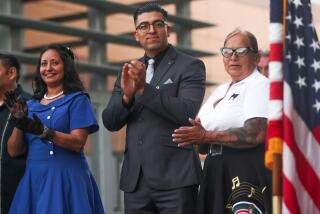WESTMINSTER : City’s Past Traced by Former Mayor
- Share via
As a member of the City Council for 20 years, Joy L. Neugebauer had been one of the architects of the city’s future. Now that she’s out of office, she says she wants to be a guardian of its past.
“I have a love affair with this city and its history,” said Neugebauer, an Ohio native who came to Westminster in 1956. “I want people to know what makes this city unique.”
A three-time city mayor, Neugebauer lost her council seat in the 1990 election. She has spent the last three years as executive director of the Westminster Museum, assembling artifacts and records of the city’s past.
She has been particularly keen in obtaining farm implements and mementos from 1870 to 1940, considered the era of the great farms when Westminster was known for its sugar beets, lima beans and dairy farms.
“We have to preserve this great agricultural heritage before it vanishes entirely from this area of Orange County,” Neugebauer said.
And she is doing so.
At the Blakey Historical Park on Westminster Boulevard, Neugebauer and the Westminster Historical Society have relocated structures owned by one of the city’s well-known farming families.
The Warne family home, a pump house and a barn, all built in 1915, were moved to the historical park in 1989. The barn now houses farm machinery used in the early 1900s, including a power rake and a wagon used to haul sugar beets to the railroad for shipment.
The red barn, measuring 72 feet by 63 feet, “looks exactly the way it used to,” said Alfred Acosta, 63, who worked as a farmhand for the Warnes from the time he was a teen-ager.
“I used to play in that barn with my brothers,” said Acosta, now a caretaker for the Blakey Historical Park. “It’s part of my life, so I love to take care of it.”
Acosta, who has never married, said he remembers when Westminster was “nothing but open land, with chicken ranches and dairy farms.”
The Westminster Museum is also at Blakey Historical Park. It is housed in the former Midway City Women’s Club building, which was moved to its present site in 1988. Built in 1929, the building has been under restoration since June, 1989, Neugebauer said.
She said that during January the museum will be open on Sundays from 1 to 4 p.m. Its displays will depict the rancho and mission days, the early settlements, the great farms in the 1930s and 1940s, and events after the city’s incorporation in 1957.
Neugebauer said that future displays will dwell on the contributions of Mexican, Japanese and Vietnamese immigrants to the city’s growth.
The museum is something young people would appreciate, particularly students, Neugebauer said. She said the Garden Grove Unified and Westminster school districts have indicated interest in conducting field trips for their students.
Neugebauer has seven sons and nine grandchildren. Her husband, Donald, a businessman, died 19 years ago. Her work with the city has kept her busy and happy, Neugebauer said.
“I love being involved. I thrive on it,” she said.
More to Read
Sign up for Essential California
The most important California stories and recommendations in your inbox every morning.
You may occasionally receive promotional content from the Los Angeles Times.










